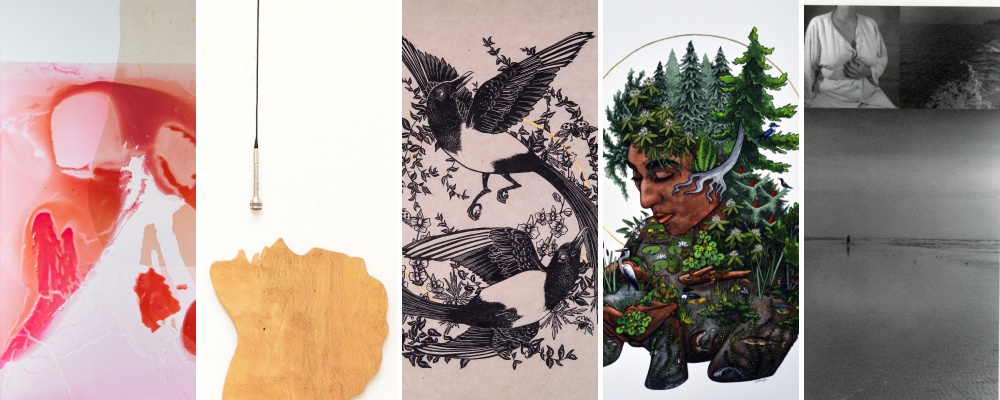Blog
Empowering Female Artists
March 01, 2023

Images from left to right; Lick (detail), Daisy Mitchell, resin and pigment on canvas, 2001. 2010.43.2; Phone Sex (detail), Erika Rothenberg, wood, metal and cable, 1991. 2009.6.2ab; Two for Mirth (detail), El Ronan, linocut and gold leaf on hanji paper, 2019. 2019.67.2; The Wetland (detail), Linnea Songer, pen, watercolor and foil, 2018. 2018.38.2; Return Trips: Flood (detail), Bea Nettles, Silver print on Luminos Charcoal paper, 1999. 2023.5.3.
In 1984, the Guerrilla Girls, a group of anonymous American female artists, created posters in response to the “International Survey of Painting and Sculpture,” an exhibition at the Museum of Modern Art in New York City. Of the 169 artists in the exhibit, less than 10% were women. The Guerrilla girls did not believe that this unequal representation of female artists was a coincidence and set to expose sexual discrimination in the world of art, referring to themselves as the “conscience of the art world."
Gender inequality in the arts is not a new topic. Female artists living just centuries ago were not allowed to have any influence in the world of art. Historically, male artists were paid more for their artwork which allowed them more freedom of experimentation, while women were expected to concentrate on domestic tasks and motherhood. Women were not allowed in art-guilds or academies, which excluded them from opportunities to show their work to those who could afford to purchase art.
Still today, as in many other professions, women are misrepresented in the arts. While the past can’t be changed, many museums and galleries are working to amend mindsets and make space for women within the galleries and collections, but there is much work to do. ArtReview’s 2018 Power 100 list of the “most influential people in the contemporary art world” included 40 women, an increase from just 32 women listed in 2016.
The GVSU Art Gallery strives to bring recognition to the achievements of all women artists from all periods and nationalities including local, national, international and GVSU alum artists. For this 2023 celebration of National Women’s History month, we’d like to celebrate a handful of the amazing female artists and the variety of mediums they represent within our collection.
Daisy Mitchell
Through the use of glossy, seemingly still wet layers of paint,
artist Daisy Mitchell creates paintings that explore the concept of
seduction through abstract forms. Mitchell plays with ideas of
intimate touch through her use of lustrous and smooth resin poured
onto a canvas. Her choices in color and techniques, such as the areas
where paint splatters and breaks up, plays even more with the senses.
Mitchell was represented by the Zolla/Lieberman Gallery in Chicago,
which is owned by GVSU Alum, William Lieberman (‘79). The gallery
historically has placed emphasis on showing women artists and other
underrepresented groups.
To learn more about works by Mitchell in the GVSU Art Collection
visit: https://artgallery.gvsu.edu/Search/objects/search/Daisy+Mitchell
Erika Rothenberg
As a well-known satirical artist, Erika Rothenberg cleverly
examines cultural and socio-economic issues with a slightly feminist
bend. In Phone Sex, she exposes the duality of aggression and
eagerness that underscore humanity's need for validation. The
silhouette's identity is kept secret like a private joke as Rothenberg
mixes traditional physical gender identifiers to create an ambiguous
personification that can become anyone and everyone.
El Ronan
El Ronan’s artwork challenges the belief that scientific
exploration can describe the details of the universe in all forms.
Using detailed imagery of flora and fauna as references to totems and
icons, she draws on themes of death, myth, and beauty, emphasizing the
intersection of the known and the unknown.
To learn more about works by Ronan in the GVSU Art Collection visit: https://artgallery.gvsu.edu/Search/objects/search/El+ronan
Linnea Songer
Linnea Songer's work is influenced by the wilderness surrounding
her hometown in the Upper Peninsula of Michigan. The environment and
natural forms are frequently utilized in her illustrations, paintings,
and jewelry. Her images exalt nature to the high position,
representing it as a powerful, life-giving force. Using the familiar
figure of mother earth, she humanizes the natural world, provoking
curiosity of the viewer to take a closer look at not only her artwork,
but the natural world around us.
To learn more about works by Songer in the GVSU Art Collection
visit: https://artgallery.gvsu.edu/MultiSearch/Index?search=Linnea+Songer
Bea Nettles
Bea Nettles has been creating semi-autobiographical works since
1970. She is known for experimenting with alternative photographic
processes and using several printing techniques like photolithography
and silkscreen. Her work tackles issues of family relationships, woven
together with mythology and natural history. She often uses her own
body to explore the ways in which personal identities can be
juxtaposed with political and social realities.
To learn more about works by Nettles in the GVSU Art Collection visit: https://artgallery.gvsu.edu/Detail/entities/6075
